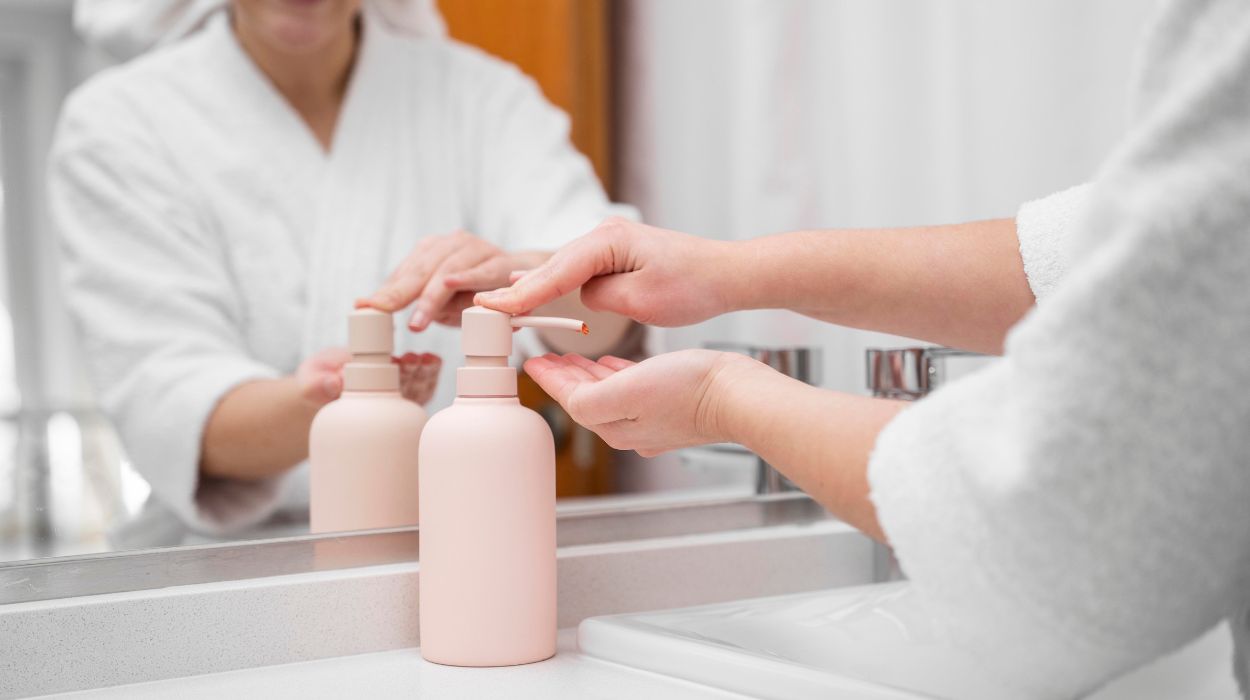How Much Hair Is Normal To Lose In The Shower? Expert’s Answers 2024

Losing some hair in the shower is a common occurrence, and up to 50 to 150 strands of hair per day is generally considered normal.[1] This shedding is part of the natural hair growth cycle. But there are environmental factors. Let’s discuss the reasons for daily hair loss and how to decrease it.
How Much Hair Is Normal To Lose In Shower?
Hair shedding can occur during a shower due to mechanical manipulation during washing. Understanding the normal amount of hair to lose in the shower is essential. Although what you see may appear to be substantial, what typically falls is usually a normal part of the natural hair growth cycle. Additionally, various factors, including genetics, age, hormones, and overall health, can influence the extent of hair loss.
How Much Hair Is Normal To Lose In The Shower?
On average, approximately 50 to 150 strands is the normal amount of hair to lose in shower. What do 100 hairs look like? If you gather 100 to 150 hairs, it is roughly a small handful or a compact cluster. The hairs would form a thin layer when spread out on a flat surface, such as what you might see covering the drain.
Hair loss in the shower is typically a result of the natural hair growth cycle, as wet hair and the act of washing or combing can dislodge loose hairs.
Causes Of Hair Loss In The Shower
You may ask, “Why do I lose so much hair in the shower?” and “How much hair loss is normal?” You may ask these questions each time you take a shower. Yes, it is normal to lose hair in the shower. The combination of wet hair and the act of washing or combing it can cause hair to fall out more easily. Though it may appear you are losing a significant amount in the shower, usually, it’s within the normal range.
To understand hair loss in the shower, it’s important to grasp the basics of the hair growth cycle.[2] Hair growth is a dynamic process consisting of three main phases: anagen: growth phase); catagen: transition phase; and telogen: resting phase. During the telogen phase, which lasts about two to three months, hair follicles are inactive and eventually shed to make room for new hair growth.
When You Need To Worry
While hair loss in the shower is generally considered normal hair loss, there are certain scenarios where it may be necessary to seek professional advice. Here are a few indicators that may need further attention:
Excessive Shedding
If you’re losing more hair in the shower than usual, it could be a sign of an underlying issue. Excessive shedding may be associated with conditions like telogen effluvium[3] which is temporary hair loss, autoimmune condition such as alopecia areata,[4] hormonal imbalances, or nutritional deficiencies.
It is important to know that not all hair on your scalp is synchronized to the same phase. It’s akin to a crop rotation, with some areas in the telogen phase, for example, and others in the catagen or anagen phase. It is usually balanced, but one phase may predominate at times, making it appear to be a sudden change in growth or hair loss.
Thinning Or Bald Patches
You may observe noticeable hair thinning or bald patches, particularly in specific areas of the scalp. This may indicate a more significant problem, such as androgenetic alopecia — male pattern hair loss or a treatable scalp condition. Or, you may be dealing with female pattern hair loss.
Sudden Changes
Sometimes you can experience abrupt changes in hair texture, appearance, or density associated with increased hair loss in the shower. This might suggest a health condition, medication side effects, or a reaction to certain hair products.
If you’re concerned about your hair loss, please consult a healthcare professional or dermatologist specializing in hair disorders.
How To Reduce Hair Loss In The Shower
Experiencing hair loss in the shower can be concerning, but there are steps you can take to help reduce hair loss. Here are some tips to minimize hair loss[5] while showering:
Be Gentle With Your Hair
Avoid aggressive scrubbing or rubbing when shampooing and conditioning your hair. Instead, use a gentle massaging motion with your fingertips to cleanse and condition your scalp. Vigorous handling leads to breakage and increased hair loss.
Use A Wide-Toothed Comb

After applying conditioner, use a wide-toothed comb to gently detangle your hair. This minimizes hair breakage and prevents unnecessary stress on the hair shafts.
Avoid Hot Water
Hot water can strip the natural oils from your scalp, leaving your hair dry and prone to breakage. You can prefer lukewarm or cool water temperatures when washing your hair to maintain its health and minimize hair loss.
Choose A Mild Shampoo

Using a mild, sulfate-free shampoo can benefit your hair. Harsh detergents in some shampoos strip the hair of natural oils and cause dryness and breakage.
Condition Your Hair
Conditioning is essential to keep your hair moisturized and protected. You can apply conditioner from mid-length to the ends of your hair, focusing on the strands rather than the scalp. This helps to keep the hair hydrated and reduces the risk of breakage.
Consult A Professional
If you’re experiencing persistent or excessive hair loss in the shower, consult a healthcare professional or a dermatologist. They can assess your specific situation, identify any underlying causes, and provide personalized advice or treatments needed.
Tips To Help Hair Grow Faster
While genetics largely determine our hair’s growth rate, there are several strategies you can incorporate into your routine to encourage healthier, speedier growth. From dietary adjustments to mindful hair care practices, let’s explore some effective tips to help you achieve your hair growth goals.
- Maintain a Nutritious Diet: A variety of nutrients[6] is crucial for hair growth. Include foods rich in vitamins A, C, D, and E, as well as biotin, iron, zinc, and omega-3 fatty acids. These nutrients mainly come from fruits, vegetables, lean proteins, whole grains, nuts, and fish.
- Scalp Massage: Massaging your scalp stimulates blood circulation to the hair follicles, promoting hair growth. Use your fingertips to gently massage your scalp for a few minutes daily or incorporate a scalp massage tool to enhance the process.
- Regular Trimming: While it may seem counterintuitive, getting regular trims helps maintain your hair’s overall health. Trimming the ends every two-three months may reduce hair shedding. It also helps prevent hair breakage and slower growth.
- Don’t Overwash: Washing your hair too frequently can strip away natural oils that are essential for hair health. Aim to wash your hair every two to three days or as needed.
- Protect Your Hair: Minimize exposure to environmental stressors,[5] such as harsh sunlight, extreme temperatures, and pollutants. When exposed to these elements, protect your hair by wearing a hat or using hair protection products.
The Bottom Line
During a shower, wet hair and activities like washing and combing can cause hair shedding. While it may seem significant, it is usually within the normal range and a part of normal hair cycling. On the other hand, several factors such as genetics, age, hormones, and overall health can affect hair loss by causing cycle phase dyssynchrony.
If you notice an excessive amount of hair loss in the shower or if you’re concerned about your hair thinning, it’s advisable to consult with a healthcare professional or a dermatologist.
+ 6 sources
Health Canal avoids using tertiary references. We have strict sourcing guidelines and rely on peer-reviewed studies, academic researches from medical associations and institutions. To ensure the accuracy of articles in Health Canal, you can read more about the editorial process here
- Sinclair, R. (2015). Hair shedding in women: how much is too much? [online] 173(3), pp.846–848. doi:https://doi.org/10.1111/bjd.13873.
- Park, A.M., Sajjad Ahmad Khan and Rawnsley, J.D. (2018). Hair Biology. [online] 26(4), pp.415–424. doi:https://doi.org/10.1016/j.fsc.2018.06.003.
- Asghar, F., Shamim, N., Umar Farooque, Sheikh, H. and Aqeel, R. (2020). Telogen Effluvium: A Review of the Literature. [online] doi:https://doi.org/10.7759/cureus.8320.
- Juárez-Rendón, K.J., Gildardo Rivera Sánchez, Miguel Ángel Reyes-López, José Elías García-Ortiz, Bocanegra-García, V., Guardiola-Avila, I. and Altamirano-García, M.L. (2017). Alopecia Areata. Current situation and perspectives. [online] 115(6). doi:https://doi.org/10.5546/aap.2017.eng.e404.
- Chiu, C.-H.T., Huang, S.-H. and Wang, H. (2015). A Review: Hair Health, Concerns of Shampoo Ingredients and Scalp Nourishing Treatments. [online] 16(12), pp.1045–1052. doi:https://doi.org/10.2174/1389201016666150817094447.
- O’Connor, K.E. and Goldberg, L.J. (2021). Nutrition and hair. [online] 39(5), pp.809–818. doi:https://doi.org/10.1016/j.clindermatol.2021.05.008.



